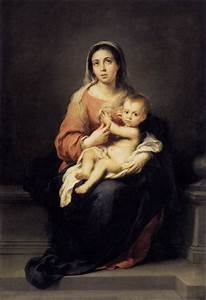Madonna and Child Murillo

April 3, 2019
During the sixteenth-century, Spain was one of the most powerful European countries, but by the start of the seventeenth-century, their power was weakening significantly. Despite Spain’s fragile economic state and their inadequate leadership, the arts thrived. This century produced some of Spain’s greatest artists, like Diego Velásquez, Francisco de Zurbarán, and Bartolomé Estebán Murillo.
From 1670 to 1672, Murillo painted Virgin and Child, an oil on canvas painting that stands at 65 ¼ x 43 inches, currently housed in the Metropolitan Museum of Art in New York. In this dark painting of the Madonna and Child, Christ is portrayed as an infant and Mary is portrayed as a young woman. Mary is sitting on a bench that is too dark for the viewer to clearly discern. She sits in a long-sleeved, loose, red gown that covers her feet. Her hair is light brown and it is kept behind her back in an untidy fashion. She has a blue cloth draped across her lap, which Christ is sitting on, and she has a brown, translucent cloth draped around her shoulders. Her right hand is down at her side, lying on the bench, while her left hand is holding Christ around his belly.
The viewer has a three-quarter view of Mary’s long face as she gazes softly and lovingly at her child. Her cheeks are slightly flushed, her lips are closed and rosy, and her puffy eyes make her appear tired, but there is nothing unique about her face; she could be any mother with her infant. Although religious paintings produced in seventeenth-century Spain are filled with symbolism, there are certain traditional symbols that are not included. Murillo did not paint the Virgin and Christ with halos. Instead, the glowing hazes that surround their heads substitute the halos. Painters in the Baroque era painted very naturalistically, and a halo would not be considered naturalistic. Despite that, artists were very dramatic in their work and the lighting that Murillo produced creates that drama, but it also alludes to Christ and Mary’s holy status.
Typically, the Virgin Mary is seen wearing blue, but in this painting, Murillo dresses her in a red gown with a blue cloth, which lies on her lap beneath Christ. Blue is a symbolic color for the people of Israel because it is the color that represents following God’s commandments, which is precisely what Mary does; blue is a heavenly color. When Mary is wearing blue, it represents mystery and the divine. The mystery is her pregnancy with Christ, despite being a Virgin, and the divine is Christ, the Son of God. In this painting, Christ is sitting on the blue cloth, probably suggesting the infant’s divinity. Red symbolizes the earth and is seen as a bloody color. This scene is moments before Christ breastfeeds from his mother, who is wearing a red gown, which is once again foreshadowing his bloody and horrific fate.









